
The canton of Bern or Berne is one of the 26 cantons forming the Swiss Confederation. It is composed of ten districts and its capital city is Bern which is also the federal city of Switzerland. The bear is the heraldic symbol of the canton, displayed on a red-yellow background.

Oberhofen am Thunersee is a municipality in the administrative district of Thun in the canton of Bern in Switzerland.

The Museum of Timekeeping and Mechanical Musical Instruments is a museum in the village of Oberhofen am Thunersee, Switzerland, in the Bernese Oberland. It is dedicated to both horology and mechanical music.
The Kyburg family was a noble family of grafen (counts) in the Duchy of Swabia, a cadet line of the counts of Dillingen, who in the late 12th and early 13th centuries ruled the County of Kyburg, corresponding to much of what is now Northeastern Switzerland.

Kasteln Castle is a castle in the municipality of Oberflachs in Canton Aargau, Switzerland. It is located west of the village on a rocky outcrop, surrounded by vineyards and woods. Today, it serves as a boarding school for students with behavioral problems. The immediately adjacent castle Ruchenstein was demolished in 1643, when the small fort was rebuilt into a Schloss Kasteln.

Schenkenberg Castle is a castle ruin above the municipality of Thalheim in the canton of Aargau in Switzerland. It was built in the 13th Century by the Habsburg dynasty, was the administrative seat for 260 years of a bailiwick of the city of Bern and fell into ruin in the 18th century.

The Erlach family was a Bernese patrician family. They first became citizens of Bern around 1300. During the 17th and 18th Centuries they were one of the leading families in Bern. For centuries the family served as senior military commanders in both Bern and in foreign armies. They were mayors of Bern and ruled over many other towns and cities in western Switzerland. Several family members received the upper nobility title "Reichsgraf".
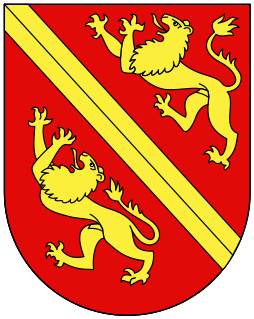
The Burgdorferkrieg or Kyburgerkrieg was a war in 1383-84 between the counts of Neu-Kyburg and the city of Bern for supremacy in the County of Burgundy in what is now Switzerland.

Unspunnen Castle is a castle, now in ruins, located in the municipality of Wilderswil in the Bernese Highlands of Switzerland. The castle, likely constructed in the early 12th century, overlooks the city of Interlaken.

Burgdorf Castle is a castle in the municipality of Burgdorf in the canton of Bern in Switzerland. It is a Swiss heritage site of national significance.

Laupen Castle is a castle in the municipality of Laupen of the Canton of Bern in Switzerland. It is a Swiss heritage site of national significance.
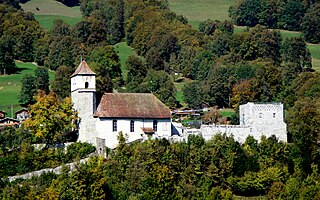
Ringgenberg Castle is a castle in the municipality of Ringgenberg of the Canton of Bern in Switzerland. It is a Swiss heritage site of national significance.

Rümligen Castle is a castle in the municipality of Rümligen of the Canton of Bern in Switzerland. It is a Swiss heritage site of national significance.

Spiez Castle is a castle in the municipality of Spiez of the Swiss canton of Bern. It is a Swiss heritage site of national significance.
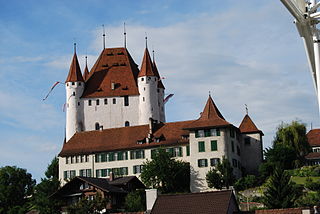
Thun Castle is a castle in the city of Thun, in the Swiss canton of Bern. It was built in the 12th century, today houses the Thun Castle museum, and is a Swiss heritage site of national significance.
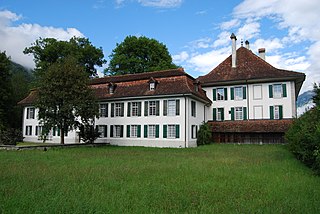
Interlaken Monastery was a convent of the Augustinian Canons Regular from about 1133 until 1528 at Interlaken in the canton of Bern in Switzerland. It is a Swiss heritage site of national significance.

The ruins of Grünenberg Castle, Schnabelburg Castle and Langenstein Castle are a complex of three interconnected castles on a hill above the municipality of Melchnau in the canton of Bern in Switzerland. The three castles formed the center of power of the Barons of Grünenberg in the Oberaargau region during the High Middle Ages.
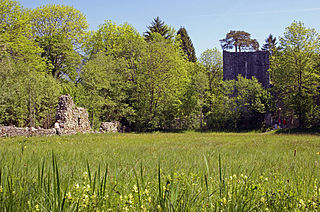
Weissenau Castle is a ruined castle in the municipality of Unterseen of the Canton of Bern in Switzerland. It is a Swiss heritage site of national significance.

Brandis Castle is the ruin of a hill fort from the 13th century. It stands in the Swiss municipality of Lützelflüh in the Canton of Bern above the village Lützelflüh on a rocky outcrop. Today, only the ruins and the moat are still visible.

Weissenburg Castle is a ruined castle in the municipality of Därstetten of the Canton of Bern in Switzerland.

























